Expert Tips for Cleaning and Caring for Cast Iron Cookware
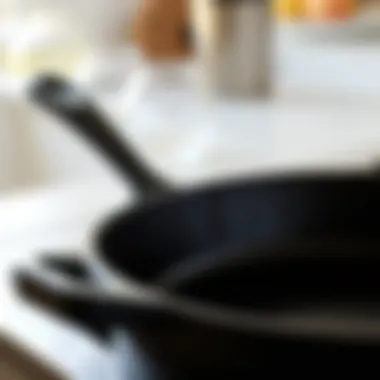
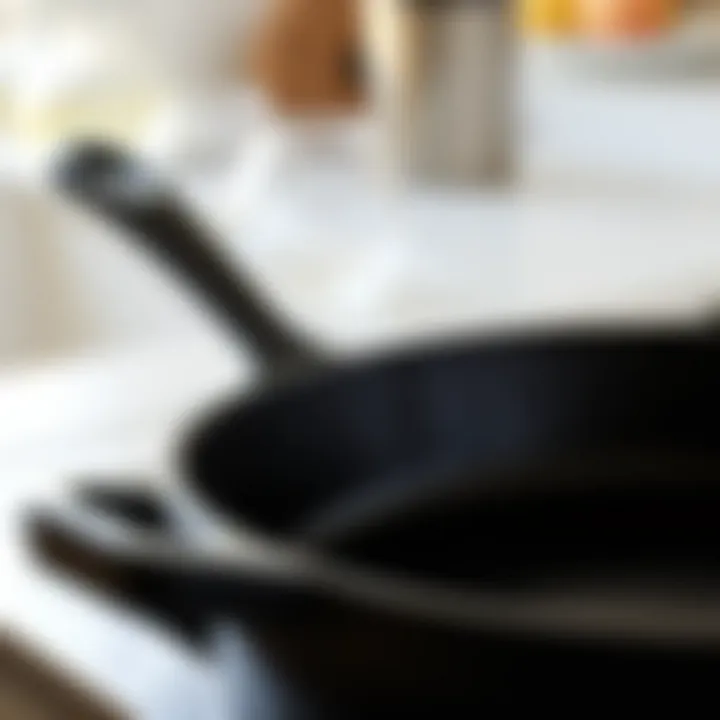
Intro
Cast iron cookware has nestled itself firmly in the hearts of cooking enthusiasts across the globe. The charm of a well-seasoned skillet is undeniable; it not only provides excellent heat retention and distribution but also carries with it a nostalgic value, often passed down from generation to generation. Yet, with great power comes great responsibility. Proper care and maintenance of cast iron are vital to keep it in tip-top shape. This guide dives deeper into the often-overlooked practices necessary for cleaning and maintaining your cast iron cookware.
Understanding the nuances of cast iron care can mean the difference between a rusty, unusable piece and a reliable kitchen companion that elevates your culinary adventures. We will explore effective cleaning techniques, discuss the importance of seasoning, and share rust prevention tips. By the end, readers will grasp the essential practices that not only preserve the functionality of cast iron but also enhance its aesthetic appeal.
The phrase “a stitch in time saves nine” rings true with cast iron care. Regular maintenance can prevent bigger problems down the road, allowing you to whip up your favorite meals without a hitch. So, let's roll up our sleeves and dive into the fascinating world of cast iron cookware cleaning and maintenance.
Prolusion to Cast Iron Cookware
Cast iron cookware has carved its niche in kitchens around the world. There’s more to this beloved material than just a rustic charm; it packs a punch with incredible versatility, being suited for slow-cooking stews, frying or searing meats, and even baking. Knowing how to care for and clean this cookware is crucial, as it can last a lifetime if tended to properly.
A well-cared-for cast iron skillet maintains its non-stick surface and enhances the flavors of the food. The process of cleaning and maintaining cast iron can seem overwhelming, especially for those new to the game. However, understanding the right techniques can transform a potentially daunting chore into a straightforward routine.
History and Evolution of Cast Iron
The roots of cast iron cookware trace back to ancient China around 500 BC. It gained traction in Europe by the 18th century, particularly with the advent of production techniques that allowed for mass manufacturing. No longer just a luxury item for the wealthy, cast iron transitioned into a staple of everyday cooking—becoming a symbol of homely comfort and durability.
As cooking methods evolved, so did cast iron cookware. It saw innovative designs and a variety of finishes, catering to changing culinary preferences. From the classic black skillet to enameled Dutch ovens, each piece tells a story of tradition and craftsmanship. The longevity of cast iron cookware is unparalleled, often passed down through generations, much like family recipes.
Benefits of Using Cast Iron in Cooking
Utilizing cast iron cookware in the kitchen provides numerous benefits:
- Durability: With proper care, cast iron lasts for decades, if not centuries.
- Heat Retention: Cast iron is known for its exceptional heat retention, promoting even cooking.
- Versatility: It can be used on any cooking surface, including stovetops, ovens, and even campfires.
- Non-Stick Properties: When seasoned correctly, cast iron develops a natural non-stick surface that enhances with use.
- Nutritional Aspects: Cooking with cast iron may even fortify food with trace amounts of iron, beneficial for those with dietary restrictions.
In summary, understanding the history and advantages of cast iron cookware sets the stage for an enriched cooking experience. Taking the time to properly clean and maintain these cherished kitchen tools pays off, allowing generations to enjoy the warmth of home-cooked meals.
Understanding the Properties of Cast Iron
When it comes to cast iron cookware, understanding its properties is pivotal. Not only does this knowledge empower you to utilize the cookware effectively, but it also enhances your overall cooking experience. Cast iron is a unique material that boasts particular qualities that set it apart from other types of cookware.
Heat Retention and Distribution
Cast iron is notorious for its ability to retain heat. This property is not just a quirk; it plays a crucial role in how food is cooked. When you place a cast iron skillet on the stove, it takes a bit longer to warm up compared to aluminum or non-stick pans. However, once it reaches the desired temperature, it holds that heat evenly for an extended period.
This characteristic ensures that when you sear meat, for instance, the surface temperature remains higher for a longer time, allowing for a beautifully caramelized crust without requiring constant adjustments to the heat.
- Practical Tip: Always preheat your cast iron before cooking; this will lead to better results, especially when frying or searing. Furthermore, it’s best to adapt your cooking techniques slightly, allowing the cast iron to shine without the frustrations of uneven cooking often seen in lesser materials.
In addition to retaining heat, cast iron distributes it remarkably well. It eliminates those nasty hot spots, making it an excellent choice for tasks such as baking cornbread or cooking delicate sauces. The even warmth ensures everything cooks uniformly, giving you consistent results.
Natural Non-Stick Surface
The beauty of cast iron cookware lies in its natural non-stick qualities that evolve with use. Unlike synthetic coatings which can peel or wear down over time, the non-stick surface of cast iron develops naturally. This process results from seasoning, which is where layers of oil polymerize and create a robust barrier against sticking.
- Why should you care? When food doesn’t stick, cooking becomes easier, and cleanup usually requires less fuss. Over time and with proper care, the smoothness of a well-seasoned skillet can rival that of any modern non-stick pan.
This characteristic not only improves the functionality of your cookware but also contributes to the flavor of dishes. With cast iron, flavors meld beautifully. A well-seasoned pan can turn out fried eggs with runny yolks and crispy edges that utilize the depths of flavor imbued by the cookware’s history.
It's crucial to note that achieving the perfect non-stick surface takes time and attention, but it's well worth the effort.
"Cast iron cooking is a dance, integrating patience and dedication over time to yield results that are both rewarding and deeply satisfying."
In summary, understanding the essential properties of cast iron — from heat retention to its natural non-stick surface — fundamentally changes the way you engage with your cookware. This reflects not just in the meals you prepare, but also enhances the enjoyment of cooking itself, creating an experience that connects you with each dish and its rich culinary history.
Basic Cleaning Techniques
Maintaining cast iron cookware requires a set of specific cleaning methods that are essential for preserving its unique characteristics. The beauty of cast iron lies not only in its cooking capabilities but also in its longevity when cared for properly. By integrating effective cleaning techniques into your routine, you ensure your cookware remains in top form, avoiding issues that can arise from neglect. Here, we explore some fundamental practices that contribute to the care of cast iron.
Cleaning Immediately After Use
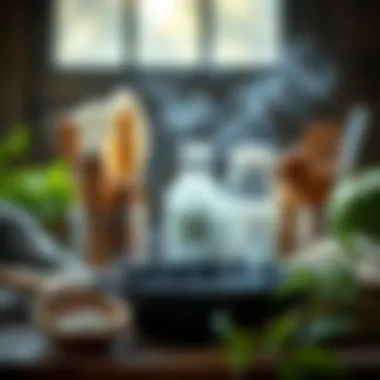
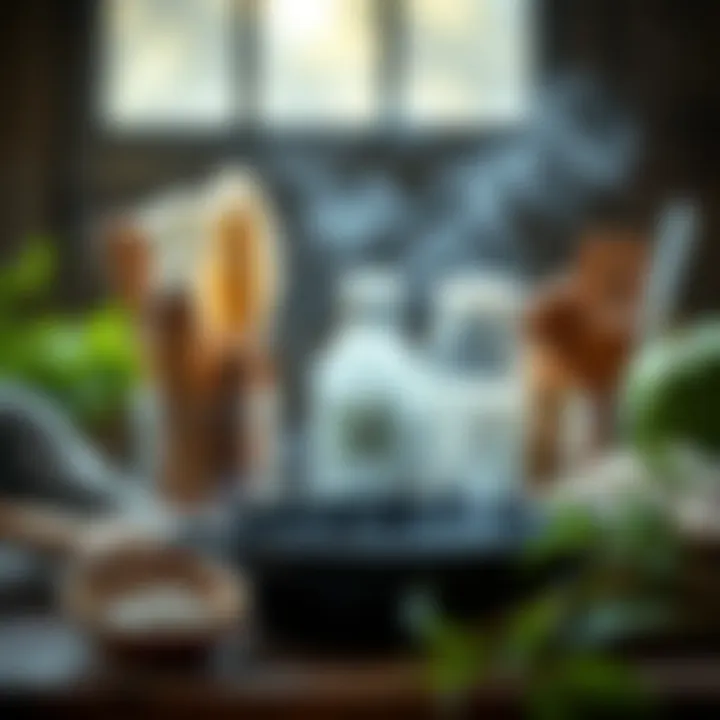
It cannot be stressed enough how crucial it is to clean cast iron immediately after you've finished cooking. Unlike other cookware, cast iron can develop stubborn, baked-on residue if left unattended. By taking a few minutes to clean your pan right after the last bite, you save yourself the hassle of scrubbing later when food particles have had time to stick stubbornly.
To tackle this, simply allow the pan to cool slightly—don't go too far, or cleaning will be a chore. Use a spatula or a brush to scrape off any food remnants. Then, run hot water over the surface and use a sponge or cloth to wipe it down, keeping the cleaning to a minimum. If done quickly, most meals leave behind little more than a sooty shadow, making cleanup a breeze.
Using Water and Scrubbing Tools
When it comes to wiping down your cast iron, the combination of warm water and the right tools will work wonders. A gentle scrub with a non-metal brush or an abrasive sponge can help lift away stubborn bits without harming the surface. A sponge made from natural materials is often recommended, but you can go for synthetic options as long as they aren’t too rough.
Additionally, for those stuck-on messes, consider using a bit of coarse kosher salt as a scrub. Pour some in after wetting the skillet, and use the sponge or cloth to work it into the surface. Not only does this method clean effectively, but it also respects the seasoning layer. The salt acts as a gentle abrasive without the harshness of steel wool or pads that could scratch the pan's surface, ensuring your cookware stays smooth and non-stick.
Avoiding Soap and Harsh Chemicals
A lot of people may find themselves surprised to hear that using soap on cast iron is generally a no-no. Though manufacturers’ formulations can be gentler nowadays, the principle is to keep all soaps at bay. These products can strip away the essential layer of seasoning on your cookware, which creates a natural non-stick surface. Over time, using soap can lead to a pan that doesn’t perform well or, even worse, a pan that develops rust.
If extra cleaning power is needed, opt for alternatives like vinegar or baking soda, but use them sparingly. For day-to-day cleaning, a hot rinse and a good scrub with plain water should do the trick. Maintaining the integrity of your seasoning not only preserves the cooking performance but also ensures a beautiful finish that you can be proud of hanging onto.
Remember, with cast iron, a little care goes a long way. Do right by your cookware, and it will reward you with years of delicious meals.
Dealing with Stubborn Residue
When it comes to cast iron cookware, stubborn residue can feel like an unwelcome house guest. It's not just about aesthetics; that leftover food can affect the taste of your next meal and even impact the longevity of your pan. Properly dealing with this residue is critical, as it prevents any buildup that could turn into an eyesore or, worse, ruin the unique cooking surface your cast iron provides. Thankfully, there are several techniques to tackle these issues, ensuring your cookware remains as functional as it is beautiful.
Salt as a Mild Abrasive
Using salt as a cleaning tool may seem like an odd choice, but it's an age-old method backed by practicality. The coarser texture of salt acts as an effective mild abrasive that helps lift away stuck-on food without damaging the seasoning of your skillet. Just sprinkle some coarse salt in the pan after you've finished cooking and scrub it gently with a cloth or sponge. This technique will often yield great results without leaving behind any detrimental chemicals or residues.
Moreover, using salt creates a sort of natural barrier: it absorbs moisture and helps prevent rust, so you're not just removing residue without harm—you're also contributing to the health of your pan.
Benefits of Salt Cleaning:
- Gentle on Seasoning: Salt won't strip away that precious layer of seasoning you’ve built over time.
- Non-Toxic: No need to worry about chemicals leaching into food.
- Easily Accessible: Most kitchens have salt sitting in the pantry, so there’s no need to purchase additional cleaning products.
While salt does effectively tackle the sheer force of dried food, it may be necessary to follow up with additional cleaning options for particularly stubborn spots.
Baking Soda Paste for Tough Spots
Baking soda is another quiet hero in the realm of cast iron care, especially for those tougher, more tenacious spots that might not budge with just salt. By mixing baking soda with a small amount of water, you create a paste. Apply this paste to the affected areas, let it sit for 10 to 15 minutes, and then scrub gently with a soft sponge. The alkaline nature of baking soda helps break down the crud, making it easier to wipe away.
Here's how it works:
- Mix the Paste: Combine about 3 tablespoons of baking soda with enough water to achieve a paste-like consistency.
- Apply and Wait: Spread the paste onto the stubborn residue and let it sit.
- Scrub Away: Use a non-abrasive sponge and scrub gently until you see improvement.
- Rinse and Dry: Once the residue has lifted, rinse with warm water and dry thoroughly.
“Baking soda not only works miracles in the kitchen but also keeps all of your cookware looking sharp and ready for the next culinary adventure!”
Utilizing these two techniques—salt and baking soda—enables you to take a proactive stance against stubborn residue, allowing your cast iron cookware to shine as bright as its performance. By maintaining this level of care, you’ll certainly notice not just the difference in your skillet's appearance but also in the flavors of the meals you create with it.
Drying and Preventing Rust
Taking care of cast iron cookware is critical to ensure its longevity and usability. After cleaning, proper drying techniques prevent rust formation, which can ruin your honing culinary tool. The significance of drying is not just about removing moisture; it's about maintaining the integrity and functionality of the cast iron. If moisture sits on the surface too long, rust can form, leading to a cycle of deterioration that could eventually compromise your treasured pan or skillet. Let’s delve deeper into effective drying methods and examine why they matter.
Thorough Drying Techniques
After washing your cast iron, drying it thoroughly is paramount. While some folks might rush this step, thinking a quick towel dry will do the trick, there’s more to it.
- Using a Towel: First, utilize a clean, dry towel to wipe down the surface. This gets rid of any droplets lingering from a wash. Don’t be shy! Use a bit of elbow grease to really ensure it’s dry.
- Air Drying: After towel drying, leave the cookware on a drying rack or hanging upside down. This helps with airflow and further encourages moisture escape.
- Avoiding Submersion: When possible, avoid soaking your cast iron in water. Submersion increases your risk of food residues sticking and encourages rust, which you undoubtedly want to avoid.
- Storing in a Dry Place: Ensure the environment around your cookware is dry. Storing in damp areas invites unwanted moisture and potential rust to settle in.
By implementing these practices, you foster an environment that promotes the health of your cookware.
Using Heat to Evaporate Moisture
In today's fast-paced culinary world, sometimes you need to think outside the box when it comes to preserving your cast iron. One effective method to ensure complete dryness is through the application of heat. Here’s how you can benefit from this technique:
- Utilizing the Stovetop: After cleaning, place your cast iron on low heat on your stovetop for a few minutes. The warmth from the burner will help evaporate any remaining moisture quickly. This only takes a few minutes – just keep an eye on it to avoid overheating.
- Oven Method: Alternatively, you can place the cookware in an oven set to a low temperature (around 200°F or about 93°C) for about 10 to 15 minutes. Not only does this drive away moisture, but it also gets your pan ready for seasoning right after.
- Checking for Fresh Rust: Always inspect your cookware after heating. If any rust appears, you’ll want to take care of it immediately to avoid further compounding issues.
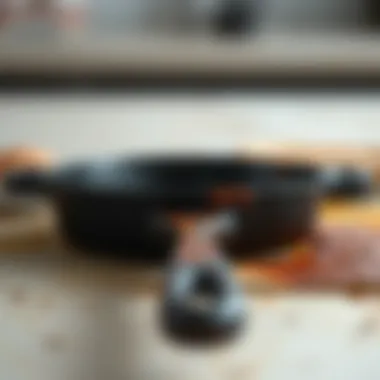
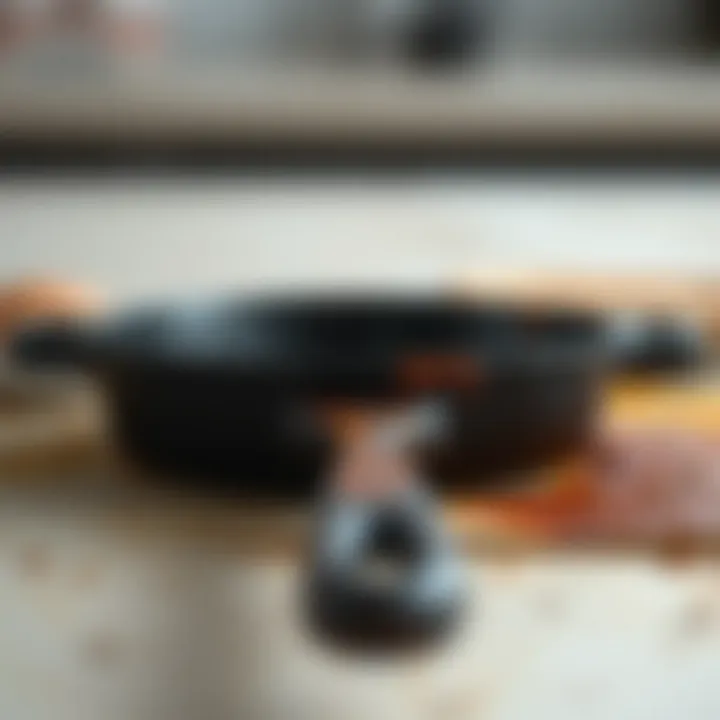
This technique helps in prepping your cast iron not just for storage but also for its next culinary adventure.
"Remember, a well-dried cast iron is like a well-prepared canvas. It’s ready for whatever masterpiece you want to create next!"
Seasoning Your Cast Iron
Seasoning your cast iron cookware is not just a step in the maintenance process; it's an art form that transforms your cooking experience. When done right, seasoning creates a naturally non-stick surface, enhancing both the flavor and texture of the meals you prepare. Imagine a well-seasoned skillet, its surface glistening from the oils baked in, standing ready to help you craft that perfect omelet or sear a steak. The importance of seasoning cannot be overstated, as it also protects your cookware from rust and prolongs its lifespan.
Selecting the Right Oil for Seasoning
When it comes to choosing an oil for seasoning, it can feel a bit like picking a wine for dinner; certain oils complement cast iron better than others. Oils with a high smoke point, like flaxseed oil, grapeseed oil, or canola oil are often recommended. Flaxseed oil, in particular, is favored by many because it polymerizes wonderfully, forming a hard, resilient layer. However, preference plays a role here. You could also use vegetable oil or even lard for a more traditional approach. The key is to ensure the oil is pure and not heavily flavored, which could alter the taste of future dishes.
Step-by-Step Seasoning Process
Effective seasoning requires a few simple steps:
- Clean the Cookware: Start with clean and dry cast iron. If it has any residue, wash it using the methods detailed earlier in the guide.
- Apply Oil: Pour a few drops of your chosen oil onto the surface. Then use a paper towel to evenly spread it over the entire pan, including the exterior and handle.
- Wipe Off Excess: It's crucial to wipe away any excess oil; too much can lead to a sticky mess instead of a smooth surface.
- Heat the Oven: Preheat your oven to 400°F (204°C). Place the skillet upside down on the middle rack with a piece of aluminum foil below to catch any drips.
- Bake for an Hour: Allow it to bake for an hour, which helps the oil to polymerize and bond with the cast iron. After it’s done, turn off the oven and let the cookware cool inside to avoid sudden temperature changes.
This process may seem lengthy, but it rewards you with a pan that cooks beautifully, lasting you many years of culinary adventures.
Maintaining the Seasoned Surface
Maintenance is key to preserving your skillet’s seasoned surface. You don't need to season every time you use the pan, but consider doing so periodically or when food starts to stick. Here are actionable tips for long-term care:
- Avoid Abrasive Cleaners: Instead, use mild tools like a sponge or a soft cloth to clean your pan after use. This prevents eroding the seasoned layer.
- Minimal Water Use: After cooking, rinse or wipe your skillet using as little water as possible. This helps maintain the seasoning while keeping the pan clean.
- Regular Conditioning: Occasionally applying a thin layer of oil after cleaning can help maintain the seasoning and ensure it remains effective. Just a dab rubbed over the surface will do.
Your cast iron will thank you for giving it the care it deserves.
"A well-maintained cast iron skillet is a cook's best friend, rewarding you with flavor and memories for years to come."
End of Seasoning
In many ways, seasoning is the heart and soul of cast iron cookware. Without it, you’re missing out not only on the practical benefits but also the joy that comes with using a cherished piece of kitchenware. So, embrace the process and let your cast iron transform into a trusted partner in your culinary journey.
For further reading on cast iron maintenance, you might check resources like Britannica or Wikipedia.
Handling Rust Issues
Rust can turn your beloved cast iron cookware from a cherished kitchen companion into a source of frustration, if not managed properly. It’s crucial to address any signs of rust as soon as they appear, since allowing it to linger only exacerbates the problem. Dealing with rust not only restores the aesthetics of your cookware, but also ensures that it remains safe and effective for cooking. Understanding how to identify and treat these pesky rust problems can bring your pots and pans back to their former glory.
Identifying Rust on Cast Iron
Before you can remedy rust, you must know what you’re looking for. Cast iron cookware typically shows rust as reddish-brown patches or spots on the surface. These rusty areas can develop over time, often stemming from moisture exposure or improper storage.
To check for rust, look for:
- Discoloration: A change in the usual dark color of cast iron, often visible in patches.
- Flaking: Cracks or flakes on the surface can indicate rust starting to form underneath.
- Texture Change: If the surface feels rough or has a gritty feel, rust is likely present.
You might also notice a shiny surface that appears duller than usual. Keep in mind that just spotting rust doesn't mean your entire piece is doomed. Catching it early and acting swiftly can save your cookware.
Rust Removal Techniques
In tackling rust, action is the name of the game. Fortunately, rust removal can be done with a few household items and some elbow grease. Here are some effective techniques:
- Scrubbing with Steel Wool: A fine-grade steel wool can be your best friend here. Use it to scrub the rusted areas gently but firmly until the rust is removed. Don’t be too rough to avoid scratching the cast iron.
- White Vinegar Soak: If the rust is extensive, you might consider soaking the piece in a solution of one part white vinegar to one part water for several hours. The acid helps break down the rust.
- Baking Soda Paste: Create a paste of baking soda and water, apply it to the rust spots, and let it sit for a few hours. Scrub the area clean afterward.
- Use Lemon Juice and Salt: A mixture of lemon juice and salt can also work wonders. The citric acid desolves the rust while the salt acts as an abrasive.
Once the rust is gone, make sure to rinse and dry your cookware thoroughly to prevent further issues.
Re-seasoning After Rust Removal
After you've stripped away the rust, your cast iron skillet needs to be re-seasoned. This ensures a protective layer is restored to keep the rust at bay in the future. Here’s how to do it right:
- Preheat the Oven: Set your oven to 350 degrees Fahrenheit.
- Choose the Right Oil: Use a suitable oil like flaxseed oil, grapeseed oil, or vegetable oil. Apply a thin layer to the entire surface of the cookware with a cloth or paper towel.
- Bake the Cookware: Place the coated cookware upside down in the oven on a baking sheet or aluminum foil to catch drips. Bake for about one hour.
- Cool Down: Turn off the oven and allow the cookware to cool inside gradually.
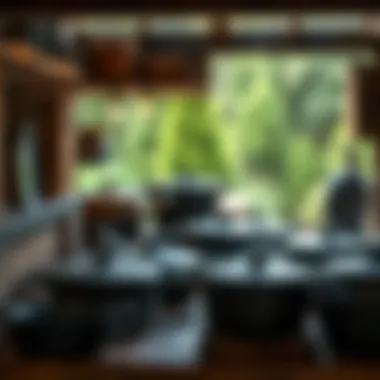
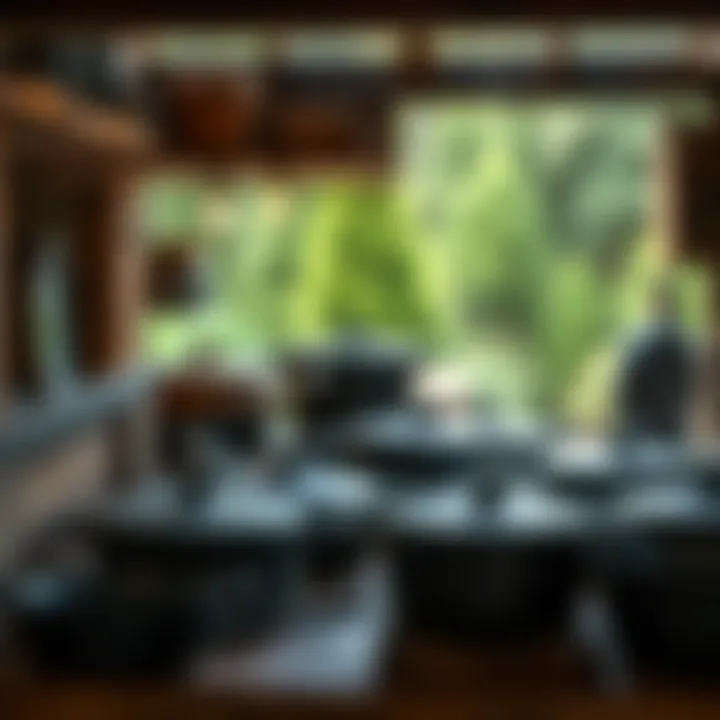
This process not only rejuvenates your cookware but also enhances its non-stick properties, allowing for better cooking performance in the future. Regular maintenance like this can significantly prolong the life of your cast iron cherished pieces.
Storage Considerations
Storing cast iron cookware properly is crucial for maintaining its performance and aesthetics over time. When cast iron is not cared for appropriately during storage, it can lead to a host of issues, notably rust and damage to the seasoning that is built up over time. A well-placed pot or pan not only safeguards the integrity of the cookware but also contributes to an efficient kitchen layout. Understanding effective storage practices allows home cooks to keep their cast iron pieces in prime condition for years.
With cast iron being a bit of a heavyweight in the kitchen – both literally and figuratively – it’s essential to have a plan in place for its storage. Ideally, your cast iron pieces should be stored in a manner that prevents them from banging against each other, which could result in scratches or chips. Moreover, environmental factors like humidity play a big role in how your cookware fares during its downtime. Therefore, a little forward-thinking can go a long way in preserving these kitchen staples.
Optimal Storage Solutions
Several strategies can enhance how you store your cast iron cookware:
- Hanging Racks: A wall-hung rack or a sturdy hook can showcase your cast iron while keeping it accessible. This method is fantastic for avoiding scratches or rust developing from contact with other metals.
- Sturdy Shelving Units: If you choose to stack your cookware, opt for deep shelves where the items won’t be cramped. Plastic or silicone dividers can help avoid scratches between frying pans or Dutch ovens.
- Dry Conditions: Ensure that the storage area is well-ventilated and not prone to moisture. A dry cupboard or pantry is best. Introducing silica gel packets can absorb excess humidity and prevent rust.
These solutions ensure your cookware is not only protected but also maintained in a manner that promotes easy access and ease of use, making it simpler to whip up that ideal meal when the time is right.
Using Paper Towels for Protection
One of the simplest yet remarkably effective ways to keep your cast iron cookware in good shape during storage is by using paper towels. Here’s how this common household item proves its worth:
- Barrier Creation: Placing paper towels between stacked pans can effectively act as a barrier. This minimizes direct contact and reduces the risk of scratching from friction.
- Absorbing Moisture: If you find yourself in humid climates or if your cookware has residual moisture after cleaning, paper towels can soak up that excess dampness, thereby preventing rust from taking hold.
- Ease of Maintenance: When it’s time to use your cast iron again, simply remove the paper towel. If it’s stained or discolored, toss it out and replace it as needed. This simple act contributes to preserving the seasoning and helps maintain an optimal cooking surface.
Tip: Always ensure your cookware is entirely dry before stacking or covering with paper towels. Moisture can ruin even the best of intentions.
By implementing these storage considerations, you can keep your cast iron cookware ready for cooking, ensuring that every meal you create will shine with the rich flavors that these pans support so well.
When to Seek Professional Help
Maintaining cast iron cookware is often manageable for most home cooks, but there are times when the damage may go beyond a simple DIY fix. Knowing when to call in the pros can save your beloved skillet from irreversible harm. Let's explore specific indicators to discern when professional assistance is advisable.
Assessing Damage Beyond Repair
Every seasoned cast iron user faces a moment when their trusty skillet shows signs of wear and tear. It's crucial to assess whether the damage is something you can handle or if it's time to enlist a professional.
- Cracks or Chips: If your cast iron has developed a crack, it's likely a deeper issue. Even a small chip can cause future complications, potentially leading to broken cookware. A pro can evaluate whether the piece can be repaired or if it's better left behind.
- Warping: When a pan gets warped, it can’t hold heat evenly, thus ruining dishes and making cooking a chore. If you notice your pan tilting or wobbling, professional help might be essential to straighten it out.
- Major Rust Damage: A little rust can often be scrubbed away, but deeper rust that seems to penetrate the metal requires specialized knowledge. A professional can remove it safely while also guiding on how to restore seasoning without damaging your piece.
Has your cast iron cookware gone through a tough time? Look closely, as the signs may be all too apparent.
Consulting Experts for Restoration
If you’ve assessed that the damage isn’t something you can tackle, it’s time to consider bringing in the professionals. Here are some pointers for making effective consultations:
- Researching Restoration Services: Check for local experts who specialize in vintage cookware restoration. Websites like reddit.com often have community recommendations.
- Communicating Clearly: When consulting, be clear about the type of damage and any attempts you’ve made at fixing it. This information will help the expert understand the history of your piece.
- Getting Estimates: Ask for an estimate before proceeding with any service. Understanding the cost helps in deciding if it’s worth it or if a new skillet would be a better investment.
"While many issues can be remedied at home, don't hesitate to seek professional guidance when the health of your cookware is on the line."
In summary, knowing when to seek expert help is vital in prolonging the life of your cherished cast iron cookware. Be attentive to signs of severe damage and trust professionals when the situation calls for it.
Finale
In the realm of culinary tools, cast iron cookware stands as a hallmark of durability and functionality. This guide has illuminated the essential practices for maintaining these treasured pieces, ensuring they serve up delightful meals for years to come. Preserving the integrity of cast iron through appropriate cleaning, seasoning, and storage techniques is paramount not just for performance, but also for the aesthetic value they bring to the kitchen.
Recap of Cleaning and Maintenance Best Practices
When it comes to caring for cast iron, a few key principles emerge:
- Clean promptly: Always clean your cookware right after use to prevent food residues from baking onto the surface.
- Avoid soap: Harsh detergents can strip the seasoning, compromising the non-stick surface.
- Utilize gentle methods: Techniques like using coarse salt or baking soda can tackle stubborn grime without damaging the iron.
- Season regularly: Keep that protective layer intact by seasoning your cast iron periodically with oils that have a high smoke point, like flaxseed or canola oil.
- Store properly: Ensure your cookware is dry and enveloped in a barrier to avoid moisture accumulation, safeguarding against rust and degradation.
These simple yet effective practices ensure that your cast iron not only retains its cooking prowess but also enhances your culinary experience.
Encouragement for Continued Use of Cast Iron
The merits of incorporating cast iron into the kitchen extend far beyond its cooking capabilities. From its remarkable heat retention to the historical significance it carries, cast iron cookware fosters a connection to cooking traditions that no other material quite matches. Embrace the idea of passing down your skillets or Dutch ovens to the next generation, reiterating the heritage and craftsmanship that comes with them.
As you navigate through your culinary journey, remember that every meal cooked in cast iron adds to its character, creating a seasoned narrative within the pan. Whether it’s a hearty stew or crispy cornbread, each dish contributes to the iron’s seasoning, enhancing both its flavor and allure. So, invest some time and thought into the care of your cast iron cookware, and you’ll find its rewards multiply at each meal shared with family and friends.
"To cook with cast iron is to participate in a tradition that spans centuries, creating not only meals but memories to last a lifetime."
By understanding and applying these principles of care, you not only enhance your cooking experience but also honor the legacy inherent in this classic cookware. Let cast iron remain an invaluable asset in your kitchen, enriching your culinary endeavors for generations.



